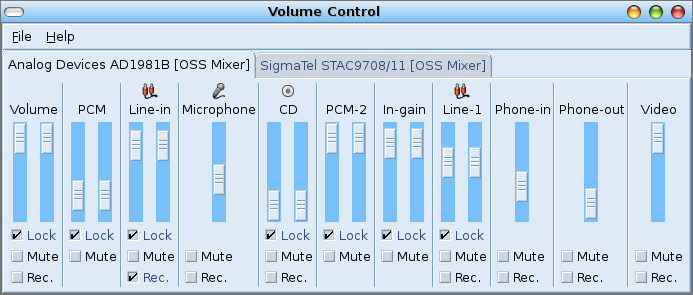
GNU/Linux Desktop Survival Guide
by Graham Williams


|
GNU/Linux Desktop Survival Guide by Graham Williams |

|
|||
Setting Up Your Audio Chip |
Generally, any onboard sound card identified is set as the default on
boot (/dev/dsp). Additional sound cards (e.g., the SB Live!
on Athens (104.7)) are identified as alternatives
(/dev/dsp1, etc.). To make the alternative sound card the
default, load the appropriate modules in the order you wish them to be
assigned in /etc/modules. For Athens (104.7) this involved:
snd-emu10k1x snd-intel8x0 |
alias snd-card-0 snd-emu10k1x options snd-emu10k1x index=0 alias snd-card-1 snd-intel8x0 options snd-intel8x0 index=1 |
To use the ALSA drivers you simply need to install the right packages
(for a 2.6 kernel or newer):
$ wajig install alsa-base alsa-utils alsa-oss |
Once your have the card working, perhaps with alsaconf,
run a mixer (e.g., alsamixer to set the volume
control:
$ alsamixer |
$ alsactl store |
If multiple cards are configured to run at the same time (i.e., not using alsaconf as above, but instead loading modules for both cards) then some audio applications allow or need the selection of the desired device for the output, usually by selecting the card model. This is true for xmms although, when using ALSA, the OSS option seems to work whilst the ALSA one does not?
A second sound card can also be accessed using the Gnome mixer if both cards are enabled:

$ alsamixer -c 1 |
An alternative, if rather messy, way to make the second sound card the
default, you could add the following code to the end of
/etc/init.d/bootmisc.sh, where the second sound card is
/dev/dsp1:
DEFAULTCARD=1
for f in dsp audio mixer ; do
mv /dev/$f /dev/${f}0 ;
ln -s /dev/${f}${DEFAULTCARD} /dev/${f} ;
done
|
Copyright © 1995-2006 Graham.Williams@togaware.com